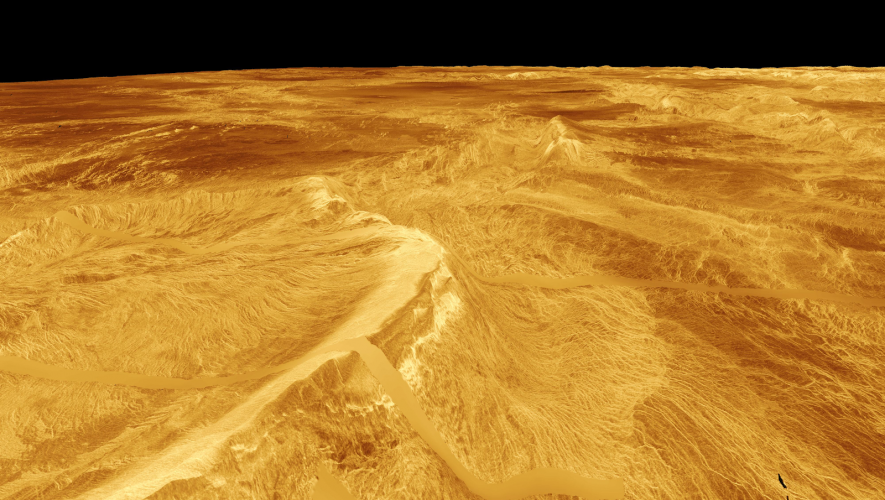Healthy skepticism is important, whether about our world or alien ones.
No one predicted 2020 would unfold the way it did. The discovery of a novel coronavirus—and the world’s response to its spread—America’s racial reckoning, and the death of Supreme Court legend Ruth Bader Ginsburg are only a few of the life-changing events that have unfolded since January.
That said, the “Most Unusual News Story” award has to go to the possible discovery of life on Venus. According to a new report, an indicator of life was detected in the Venusian skies. Amidst significant Earthly turmoil, it’s refreshing to read about the theoretical existence of otherworldly, bacteria-like organisms.
But there’s more to this story than meets the eye. In the age of information, it is necessary to stay accurately informed through critical evaluation of nuanced evidence.
Goldilocks on Venus
The most important would-be enablers of life on Venus are the Goldilocks Zones in its atmosphere. Besides the Sun, Venus’s surface is the hottest place in the solar system, with temperatures reaching higher than 470°C. The only sliver of hope for life resides in Venus’s densely clouded skies. Thanks to patterns of air circulation known as Hadley Cells—which prevent superheated air from building up in any one location—the temperature and pressure of these Goldilocks Zones hover around a mild 60°C and an Earth-like one atm (standard atmospheric pressure). Temperatures of 60°C are inhospitable to humans, but many of Earth’s microbial thermophiles thrive in temperatures around 85°C.
The composition of Venus’s defining cloud plumes—massive quantities of carbon dioxide, sulfuric acid, and iron—also allow for inhabitation. With help from the Sun, a microbe could extract carbon from carbon dioxide and convert it into molecules that help generate energy from environmental sulfur (derived from sulfuric acid) and iron.
The microbe A. ferrooxidans exemplifies this process. A. ferrooxidans is most comfortable in extremely acidic environments and derives energy from naturally occuring hydrogen, iron, or sulfur to construct complex carbon dioxide derivatives that it needs to reproduce.
But the potential for life on Venus wasn’t always confined to its atmosphere. NASA computer modeling suggests that Venus’s topography was once defined by shallow liquid-water oceans and large land masses. Its climate was, at one point, Earth-like. It is possible that the oceans there were capable of supporting life. After carbon dioxide levels spiked and the surface baked, ancient oceanic thermophiles may have been forced to migrate to Venus’s atmosphere within evaporating water droplets, where they live today.
But contending that life is likely to exist on Venus with confirmatory evidence alone omits relevant and meritorious counterarguments.
Life on Venus: Is It Realistic?
A microbe suspended in water droplets within Venus’s cloudscape would have to withstand a constant onslaught of environmental forces threatening to tear it apart. It cannot be overstated how difficult it is for life to survive in such a climate.
After at least 3.7 billion years of evolution on Earth, only 582 of the 14,487 different microbes recorded in the BacDive database can survive temperatures higher than 45°C. Unfortunately for Venusian microbes, Venus’s Goldilocks Zones average 60°C. Additionally, the same atmospheric sulfuric acid that a microbe could use for energy severely limits the chance of it existing in the first place. Of these 582 thermophiles, only one (Acidianus sulfidivorans) can survive intense acidity, high quantities of sulfur, and temperatures hotter than 60°C.
However, this microbe lives exclusively near hot springs where liquid water is abundant, a habitat far from Venus’s atmosphere of carbon dioxide and concentrated acid whipping around at 360 kph. Not to mention that liquid water is scarce in Venus’s clouds, with more common water vapor comprising only 0.002 percent of its atmosphere, compared to Earth’s 0.4 percent. Even A. ferrooxidans, the ostensible paradigm of potential Venusian microbes, survives best in temperatures around 25°C.
One can argue that no Earthly life form can survive on Venus because no Earthly life form has ever had to. But it is more probable that Venus’s atmospheric conditions prevent life from forming in the first place. It would be almost impossible for a microbe to survive temperatures of 60°C, extreme acidity, high carbon dioxide concentrations, the wear and tear of rapid wind, all without prevalent liquid water, at once.
What’s All the Fuss About?
Recently, excitement about life on Venus was revived by Greaves et al.’s discovery of phosphine in its atmosphere. Phosphine is unstable in temperate conditions and, on Earth, is produced only by life. Scientists have proposed that it is a biosignature gas, one that indicates the presence of living organisms.
However, interpreting phosphine as a biosignature is scientifically valid only in the context of temperate planets, and Venus is far from temperate. Even literature cited by Greaves et al. notes that “phosphine is an extremely promising biosignature gas” if detected on a temperature planet. They point out that phosphine can be found naturally in hydrogen-rich atmospheres hotter than 526°C with pressures higher than 0.1 atm.
Venus nears or meets all of the criteria for natural phosphine production. At its surface, temperatures regularly approach 482°C and pressure averages 92 atm. Water vapor, though relatively scarce, reacts with iron to generate hydrogen gas. But even so, some scientists doubt that the report ever observed phosphine in the first place. According to NASA researcher Michael Way, “it’s not 100% clear exactly what they have measured,” due to unexplained variations in their readings.
As of now, there are no known chemical pathways on Venus capable of explaining phosphine production, even after Greaves et al. ran seventy-five reactions at a wide range of conditions. However, this uncertainty does not itself imply the presence of life. As the researchers noted, “the detection of [phosphene] is not robust evidence for life, only for anomalous and unexplained chemistry.”
Venus and Politics
It is unlikely that life exists on Venus, but that doesn’t stop some media outlets from hyping the possibility. Many Americans seem drawn towards unsubstantiated but shocking theories. Maybe there is something psychological to it. Anchoring bias, availability heuristics, the bandwagon effect, and outcome bias are just a few of the many forces that can shape our perspectives and opinions if left unchecked.
In the political realm, these influences become obvious. In March 2018, most Democrats incorrectly believed that Russia tampered with vote tallies to get President Trump elected, while most Republicans denied that Russia spread pro-Trump fake news despite overwhelming evidence.
As political polarization pervades society, conservatives and liberals alike are retreating to their respective ideological echo chambers and discounting any opposition as lacking credibility; devotion to unfalsifiable political dogmas is becoming increasingly common. Our desire to see the world a certain way creates false perceptions of how it actually is.
This couldn’t have been clearer than in the political responses to California’s rampant wildfires. There is solid evidence that the severity and frequency of California heat waves have increased over the last century due to human-caused climate change. But brazen headlines concluding that “Fast-Moving California Wildfires [are] Boosted by Climate Change” omit another notable cause: improper forest management.
Over the past century, policies of fire suppression—the rapid extinguishing of forest fires—have allowed forests to become dense and susceptible to threatening infernos; overlapping tree crowns and the buildup of dry logs can fuel severe blazes. In 2018, Scott Stephens, a wildfire specialist at the University of California at Berkeley, predicted that suppressing frequent, low-to-moderate-intensity fires would increase mass fire frequency in the near future. Consistent with the “bad forest management” explanation, anthropogenic warming is not associated with wildfires in California’s non-forested regions. Like the possibility of life on Venus, the causes of California’s wildfires are complex in a way most headlines don’t capture.
It is refreshing to read about possible life on Venus after all we’ve endured on Earth. But really, the subject of Venusian microbes isn’t all that different from Earthly matters. For both, there is more to the story than meets the eye. In this way, claims of life on Venus highlight the need for an informed public more generally. As with any purportedly groundbreaking news, skepticism of life on Venus—refusing to view our world or other worlds through a binary lens—is crucial. News outlets have a responsibility to seek diverse perspectives from different reputable experts; that way their readers can weigh the best versions of competing arguments.
Maybe if we took a step back, acknowledged that we suffer from the same biases, and afforded those who disagree with us the benefit of the doubt a little more, we wouldn’t need the Venus story to remind us to be skeptical.




